NFT rarity tools are the quickest way to find top-ranking NFTs. However, there are so many tools used to check rarity and analytics that it can quickly become an overwhelming task. So, what are the best rarity rank and analytic tools and how do you find the top ranking NFTs?
To answer this question once and for all, I tested over 21 NFT rarity tool checkers, ranked them accordingly, and gave them my honest review.
I ranked each tool/platform based on four factors:
- User experience
- Key features
- Variety of NFT collections covered
- Cost
What Are the Best NFT Rarity Tools?
After testing each rarity tool extensively, here’s my review of the 21 best NFT rarity and analytics tools.
1. Rarity.Tools (Best Overall)
Rarity.tools is an NFT ranking tool used to find the top NFTs in a collection. Using the tool’s well-laid-out pages, you can easily scan collections for their highest-ranking NFT. You can filter by traits, including the number of traits a specific NFT has.
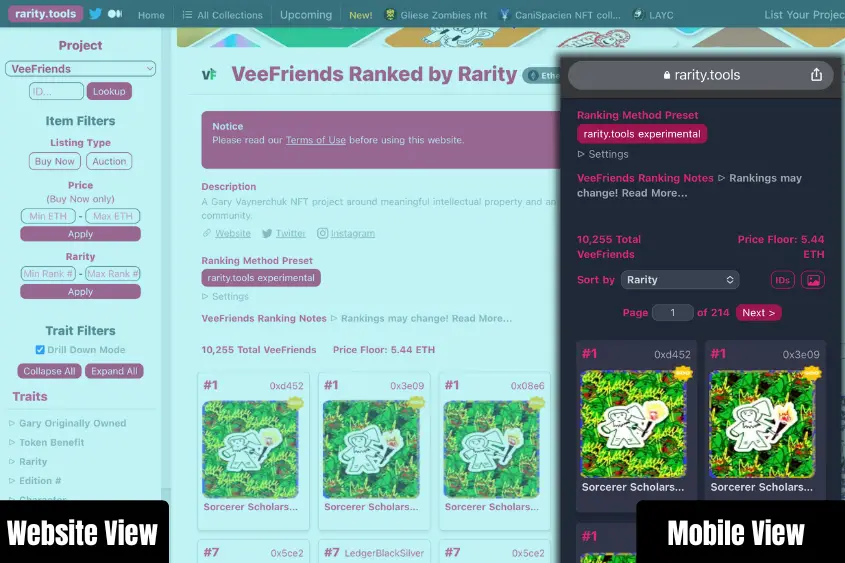
Moreover, you can set rarity filters to look within a specific range of rarity. Rarity.tools also gives you a breakdown of each NFT based on its traits.
Ultimately, these traits are used to compute the NFT’s rarity score. You can also check the rarity of an NFT by simply entering its Token ID.
Besides rarity, Rarity.tools also provides you with a brief overview of each collection including the current floor price, total number of tokens in a collection, number of owners, total sales volume, and a 7-day average price.
User Experience:
Rarity.tools is one of the most simplified NFT rarity trackers available. They categorize collections by newly added, more recent, and top collections, allowing you to easily find the project you’re looking for.
Or, you can just as easily use the search bar to quickly navigate to the NFT you’re looking for. Overall, the website loads quickly and is easy on the eyes.
Key Features:
- Easily filter by collection name, trait, rarity, price, and Token ID
- OpenSea and LooksRare integration for easy sniping
- Upcoming Drops page with mint time and location
- Features both Ethereum and Solana NFT collections
- Detachable windows for a convenient analysis experience
Variety of NFT Collections Covered:
Rarity.tools covers a wide array of NFT collections. You will find the most popular brands like CryptoPunks, Bored Ape Yacht Club, and VeeFriends.
But, you will also notice there are lesser-known projects listed on the site. Overall, there’s a good variety of NFTs to satisfy your rarity ranking needs.
Cost:
Free: Rarity.tools is free to use for everyone.
Listing price: To list your collection costs 2 ETH (for Ethereum projects) or 20 SOL (for Solana projects.)
Like:
- Scores NFTs based on their various traits and rarity
- Compares relative values of individual NFTs
- Ranking is customized for each project
- Includes other important details about each collection
Dislike:
- Does not display all projects
- The cost to list a project is hefty
2. Rarity Sniper (Best Runner-Up)
Rarity Sniper’s creator started off by coding a simple program for sniping rare NFTs. After realizing he wasn’t the only one who wanted to snipe NFTs, he created Rarity Sniper.

Sniper ranks over 1,800 NFT collections. You can search the platform using filters for traits, meta traits, rank, and price.
The website even has a page displaying NFT prices and statistics including the trends, floor price, sales volume, and more.
With over 479,000 followers on Twitter and 319,000 Discord members, Rarity Sniper has the largest community out of all the rarity ranking tools.
User Experience:
Rarity Sniper was created with the user in mind. The website utilized multiple tabs for easy navigation.
Tabs include: NFT collections, Drops Callendar, News, Stats, and New Features or you can search a collection by name. The platform is smooth and works well on both mobile and desktop versions.
Key Features:
- Supports a variety of blockchains including Solana, Ethereum, Klatyn, BNB, and Polygon.
- Provides links to each collection’s social pages and official website.
- NFT Drops calendar provides info about upcoming NFT drops.
- Filter a collection by “Buy Now”, which allows you to purchase the NFT on Opensea.
- Dark and light modes for easy viewing
Variety of NFT Collections Covered:
Rarity Sniper provides rarity rank for nearly 2,000 NFT collections across five blockchains.
Cost:
Free: Rarity Sniper is free to use. However, if you want to list your collection, you have to pay.
Like:
- The founder understands the desire to track rare NFTs better than anyone else
- One of the largest communities out of any NFT rarity tool
- Extremely active on social media
- Friendly user interface
- Mobile and desktop friendly
Dislike:
- The collection search bar is small and you have to know the name of the project you want to search for to find it easily.
3. Trait Sniper (Best Rarity Tool Extension)
Trait Sniper is best described as a metadata sniffing tool. It calculates NFT rarity as soon as NFT is revealed which can lead to early opportunities if utilized properly.
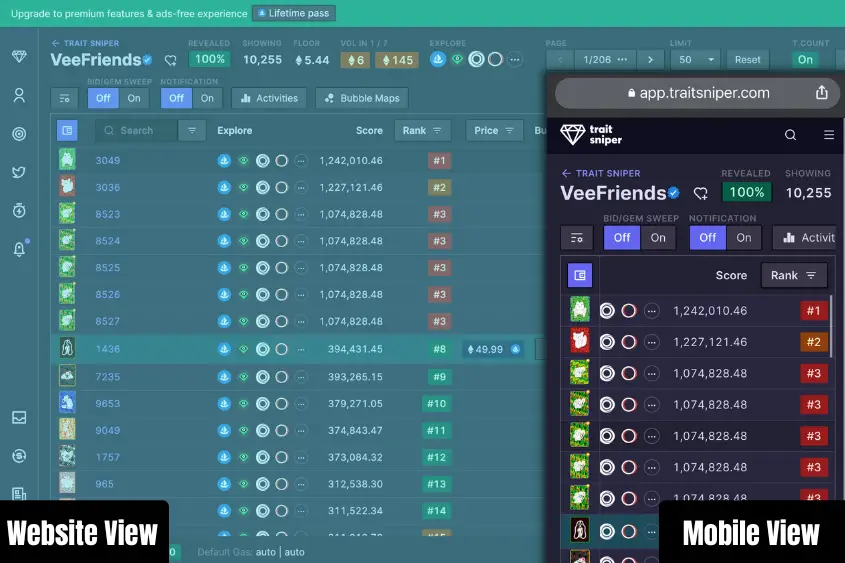
With over 2 million monthly users, 3,000 plus projects listed, and more than 100,000 extension downloads, Trait Sniper is one of the most utilized rarity tools.
You can use the tool directly on the website via your desktop computer or on your mobile device by launching the app.
Or, you can download the Chrome extension to use on a number of NFT marketplaces like Opensea, LooksRare, and X2Y2 to name a few.
It’s important to note that Trait Sniper is much more than a simple NFT rarity checker.
You can set up auto-sniping, wallet watch, and mass bidding to snipe good deals before anyone else knows they exist. It’s an all-in-one tool used by both novices and whales in the market.
User Experience:
Trait Sniper has a lot going on. When you first land on the website, it can be overwhelming.
There’s no direction as to where to start, but there are a lot of features such as FAQs and testimonials that help you learn more about the tool.
If you are just getting into NFT research, Trait Sniper might be a bit too much as there is a slight learning curve to using the tool.
In addition, when you launch the app on your mobile device it’s difficult to view because of the amount of data this tool provides.
My favorite feature of Trait Sniper is the Chrome extension.
Once installed, you can quickly view an NFT’s rank, floor price, and the price that other marketplaces have that particular NFT listed for all within the marketplace you’re using.
Key features:
- Chrome extension for easy simplified rarity checks
- Multiple membership tiers with varying levels of utility
- Mass bidding
- Wallet watch
- Auto sniping
- Instant reveal ranking
Variety of NFT Collections Covered:
There’s no doubt that Trait Sniper covers a ton of NFT collections across multiple marketplaces. With over 3,000 NFT projects covered, Trait Sniper is more than likely to have the NFT project you want to research.
Cost:
Free: The Free option gives you access to basic tools such as the unified trading interface, live event feed, and general usage of the Chrome extension (check rarity and ranking of NFTs.)
Alpha: The Alpha tier offers everything the free version provides plus the Chrome extension Quick Buy option and other advanced features. Also, you gain access to listing alerts, reveal calendar, alpha group, and wallet watcher.
Genesis: The Genesis tier enables access to all the tools including auto buy, mass bid mode, genesis group, and instant rarity rankings upon reveal.
Since the Alpha and Genesis tiers are NFT memberships, the prices constantly fluctuate. You can view the current price on Opensea.
Like:
- It’s a true all-in-one NFT rarity and data analysis tool
- You can choose how much access you want depending on your personal needs
- The Chrome extension allows you to view NFT rarity and rank while viewing the marketplace platform
- Trait Sniper is partnered with some of the top brands in the NFT space
Dislike:
- The tool has a slight learning curve
- The interface seems confusing and cluttered
- The mobile page does not display well
4. NFT Stats (Largest Variety of NFT Stats)
NFT Stats is a dedicated rarity tool that provides you with the latest statistics of over 100,00 NFT projects.
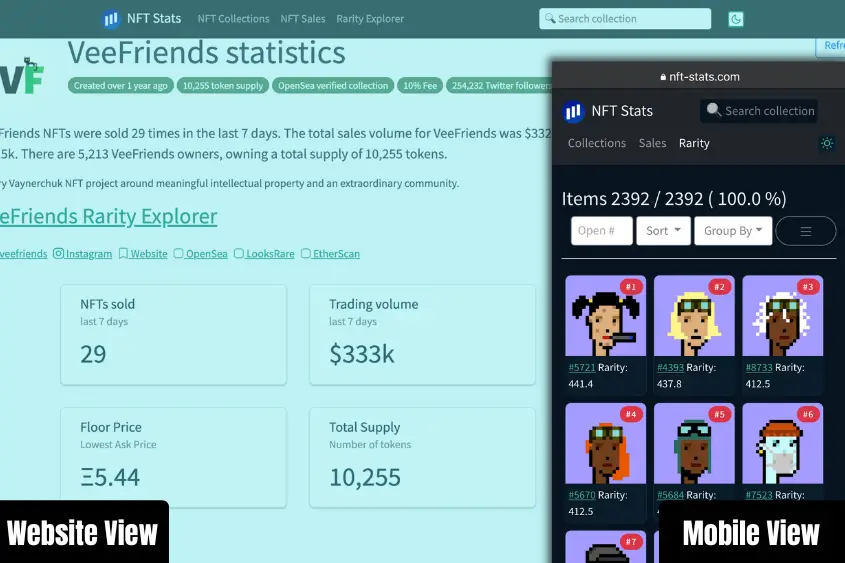
This tool is perfect for finding the best NFT to buy, discovering upcoming projects, and staying up to date with current collections on the market.
Data is sourced from multiple NFT marketplaces and from the project creators themselves.
One huge advantage that NFT Stats provides is community statistics directly from Twitter and Discord.
That means you can know every single detail about an NFT without needing to visit any other platform. Of course, you can explore the rarity of any NFT collection as well.
User Experience:
NFT Stats does a great job of providing massive amounts of data in a simplified way. The website isn’t overly crowded and you can easily search for any NFT collection you’d like by name.
The main page displays a list of the top-ranking NFT projects (within the last 24 hours) in addition to upcoming NFT projects.
When you click on a specific NFT project, you can view the amount sold, trading volume, average price, floor price, total supply, and the number of owners.
Moreover, NFT Stats displays a convenient price chart that showcases the last 3 months of sales when viewing a project.
Though you can view details of over 100k NFT brands, you can only view the rarity of a select few projects.
If you’re solely looking to explore the rarity of NFTs, NFT Stats might not be the best choice. Also, the rarity explores function performs poorly on mobile devices.
Key Features:
- Explore data of over 100,000 NFT collections
- NFT price chart to analyze price trends over the last 3 months
- An FAQ section breaking down the details of each NFT project
- Top sales list of NFTs over the last 24 hours, 7 days, and 30 days
Variety of NFT Collections Covered:
NFT Stats provides data for over 100k NFT projects. But, the number of projects it provides rarity rankings for is minimal.
Cost:
Free. NFT Stats is free to use. There may be a fee to list your collection though.
Like:
- Simple interface
- It shows related projects and what other NFT collections the holders of one project own
- You can easily view Discord member stats
- The FAQ for each NFT collection is helpful
Dislike:
- The number of projects available to view in the Rarity Explorer is minimal
- There are some “fake” collections I found listed in the Rarity Explorer that were no longer listed on the marketplace
5. CryptoSlam (Best Free Aggregator Tool)
Cryptoslam is one of the oldest and most respected platforms in the NFT data analysis game.
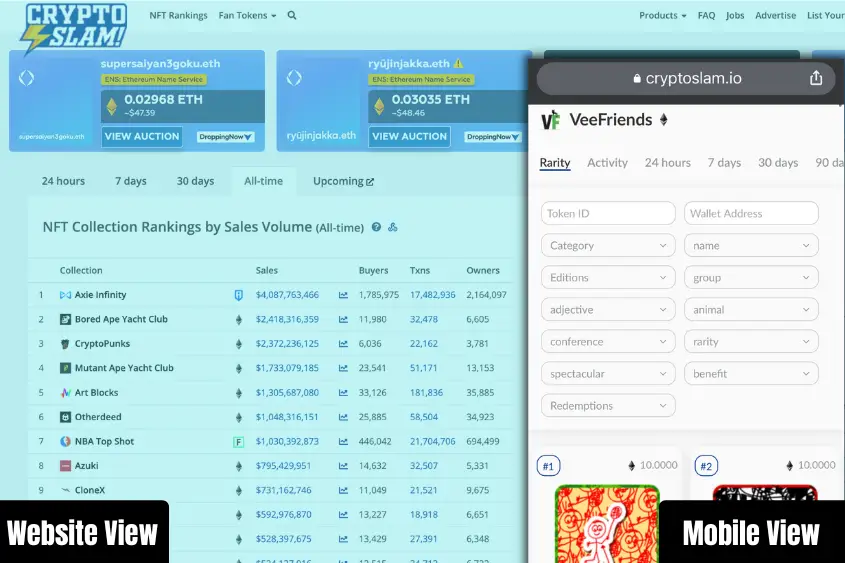
It was created in 2018 by Randy Wasinger to track MLB Champions digital collectibles.
Since then, the platform has become one of the most popular NFT aggregators in the web3 space.
The site features over 2 million NFT projects and allows you to track NFTs by their sales volume and view the total transaction volume of numerous NFT-capable blockchains.
Cryptoslam can be used as a rarity tool or as the ultimate NFT aggregator tool.
Cryptoslam’s analysis and tools are used by hundreds of thousands of NFT enthusiasts to find and invest in a broad range of digital assets.
It’s safe to say that Cryptoslam is developing one of the most comprehensive tools for viewing and studying NFTs.
User Experience:
Cryptoslam is quick and easy to use. You can view the website on both mobile and desktop devices, and I’ve never experienced any downtime when using the site or noticed any lag.
That said, Cryptoslam provides so much data that it can be hard to decipher what you’re looking at, especially if it’s your first time using it.
But, if you spend a few minutes on the platform, I think you’ll find that it’s really easy to use.
Key features:
- Shows whether the NFT is bullish or bearish
- You can see the bestselling NFTs in the last 24 hours, 7 days, 1 month, and all time.
- Displays blockchain metrics by NFT sales volume
- You can search by wallet names and addresses
- You can view live sales
Variety of NFT Collections covered:
Cryptoslam collects data for over 15 different NFT-capable blockchains.
Cost:
Free: Cryptoslam is completely free to use. However, if you want to list an NFT collection, you can pay a $2,000 acceleration fee to prioritize your listing to the top of the queue. Also, if you want to advertise on their site, Cryptoslam works with budgets as low as $1,000 to over $20,000.
Like:
- The platform offers a lot of data free of charge to the user
- Shows current transaction fees
- Works across several blockchains
- Displays the top buyers and sellers
Dislike:
- There’s a slight learning curve to navigating the website
6. Opensea Stats (Best for Beginners)
Opensea is undoubtedly the most popular NFT marketplace in the web3 space. Since its creation, the platform has done over $32 billion in sales, and continues to be the go-to marketplace to buy, sell, and trade digital assets of all types.
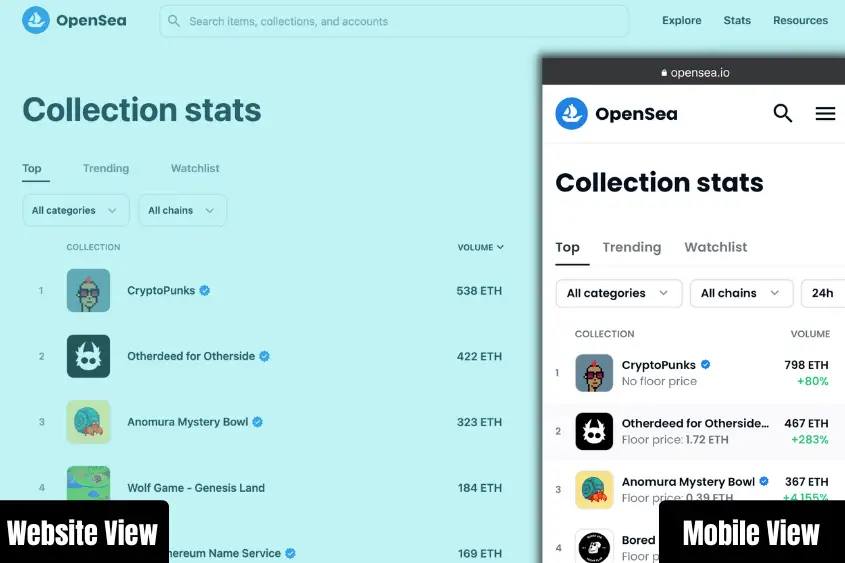
But, did you know Opensea also provides an extremely useful “Stats” tab that displays details about the top NFT collections across Ethereum, Polygon, Solana, and Klaytn blockchains?
Opensea’s Stats lists the top-performing projects by sales volume as well as what’s trending.
You can also set up an account to create a watchlist of your favorite NFT projects.
Notably, Opensea does not provide rarity rankings. However, you can easily filter an NFT collection by its traits, price, and listing status.
User Experience:
If you are at all familiar with Opensea, then you’ll have no issue navigating the Stats page.
When you click on the Stats tab, you have two options to choose from; Rankings and Activity.
Rankings allow you to view the top performing NFT collections (24 hours, 7 days, 30 days, and all-time), while activity provides you with a live stream of marketplace activity including sales, listings, offers, and transfers.
Opensea works well on desktop and mobile devices. My only complaint is that the platform often experiences downtime due to updates.
With that, they try to perform these updates during the least busy hours.
Key features:
- View top NFT collection stats
- View a live stream of marketplace activity
- Tade, curate, and track all on one platform
- Add your favorite projects to your watchlist
Variety of NFT Collections covered:
Considering Opensea is the largest NFT marketplace, they provide details for thousands of NFTs on Ethereum, Polygon, Solana, and Klaytn blockchains.
Cost:
Free: Opensea’s Stats function is free for anyone to use.
Like:
- Opensea is a trusted NFT marketplace where you can track and trade in one place
- Each NFT trait is specified
- The platform offers details for numerous blockchains
Dislike:
- NFT rarity is not displayed
- The site can be slow or is down at times
7. Uniq (Best Overall Data Analysis Tool)
Uniq is a free NFT data analytics platform that provides real-time insights and high-fidelity data of over 25,000 NFT projects and growing.
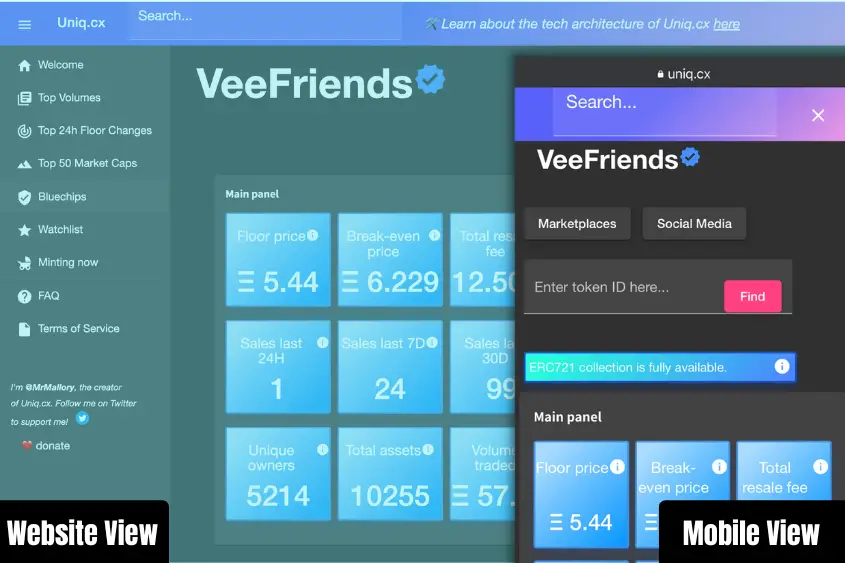
Currently, Uniq only tracks NFT projects on Ethereum but there are plans to expand to Polygon, Solana, and Klaytn as well.
There are two “modes” or levels of tracking offered by Uniq.
Full Mode tracks the 7,000 NFT collections that show the most activity. This tracking includes every sale, listing, and even the rarity of each asset.
Floor Mode tracks the rest of the NFT collections that experience a lot less activity. Therefore, only the floor price of these collections are displayed. Nevertheless, it’s possible to activate full mode for certain collections if users begin to show stronger interest.
User Experience:
Where do I start? Uniq is, well, unique. There is so much helpful data that it’s actually overwhelming.
There are many cool features offered by Uniq that you won’t find anywhere else. And the craziest part is that it’s available for free.
I was also surprised to find out that the mobile version works just as well as the desktop version.
Considering the number of charts and tabs, I thought this was going to be an issue.
In fact, I think I enjoy the mobile version even more since it only displays one chart at a time compared to the desktop which showcases many.
If you want the ultimate NFT data analysis tool, Uniq is it.
Key features:
- Blue chip collections tab
- Customizable watchlist
- “What’s minting” tab
- Top 50 market cap
- Top 24-hour floor pumps and dumps
- Top 25 whales (wallets with the most assets in a given collection)
- Best rank for the money (cheapest assets within a given rank bucket)
Variety of NFT Collections covered:
Uniq provides data for over 25,000 Ethereum NFTs with plans to integrate Polygon, Solana, and Klaytn assets in the future.
Cost:
Free: Uniq is completely free to use forever.
Like:
- Has data analysis features you won’t find anywhere else
- Allows you to easily find the top-ranking NFTs for the best deal
- Provides a comprehensive overview of over 7,000 NFT projects
- Dashboard charts provide unique insight into the top NFT projects
Dislike:
- The amount of data displayed on the platform is overwhelming
8. DappRadar (Most Trusted Data Analysis Platform)
DappRadar is the largest data tracking platform of web3. The platform provides information about all the existing dapps and is the most trusted data analysis tool in the industry.
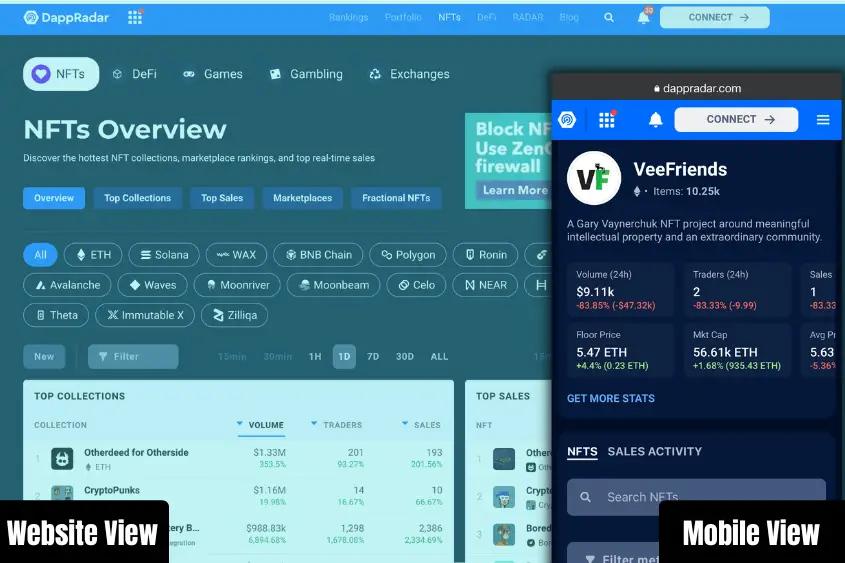
With that, DappRadar doesn’t just track NFTs, they track nearly every single decentralized application, NFTs are just one aspect.
Furthermore, they offer comprehensive NFT valuation and portfolio management and are known for their actionable industry reporting.
Currently, DappRadar tracks over 25 NFT-capable blockchains, which means you’re sure to find all the data you need on any NFT.
User Experience:
Obviously, DappRadar’s platform is extensive. But, for this review, I’m solely speaking on the NFT portion of the platform.
For as much info as DappRadar provides, the user experience is actually really enjoyable.
You can view NFTs by blockchain, and further filter by top collections, sales, marketplaces, and even fractional NFTs.
On top of that, you can view these statistics on a 15 min, 30 min, 1-hour, 1-day, 7 days, and all-time basis. To be transparent, the 15 and 30-minute options are only available for users who have a PRO account.
Overall, DappRadar provides just about all the info you’d need to know about an NFT project (except rarity rank), it’s easy to navigate, and it doesn’t lag.
Plus, it works just as well on mobile as it does on the desktop version.
Key features:
- Top collections overview
- Top sales overview
- NFT marketplace overview
- Fractional NFT overview
- 20+ blockchains covered
- NFT value estimator
- Super insightful blogs with market updates
Variety of NFT Collections covered:
DappRadar provides information for over 8,000 NFT collections spanning 20+ blockchains such as Ethereum, Solana, Polygon, Flow, WAX, Tezos, Immutable X, and a whole lot more.
Cost:
Free: DappRadar is free to use for its basic features.
PRO: Enjoy premium content and access, enhanced data, live notifications via Discord, plus a ton more features in the future for a cost of 5,000 RADAR tokens (DappRadar’s native currency).
Like:
- The free version offers plenty of analytical data
- Numerous filters allow you to breakdown NFT collections by blockchain, project, and marketplace
- DappRadar is the most trusted data source in the web3 space
Dislike:
- If you are only interested in NFTs, DappRadar might be a bit of an overload
- If you want additional features, you need to hold 5,000 RADAR tokens (about $40)
9. Inspect (Best NFT Social Intelligence Tracker)
Inspect is an NFT social and collection ranking tool used to detect the most active community members on Twitter. Also, you can view brief analytics of NFT collections including their floor price, total volume, items, and owners.
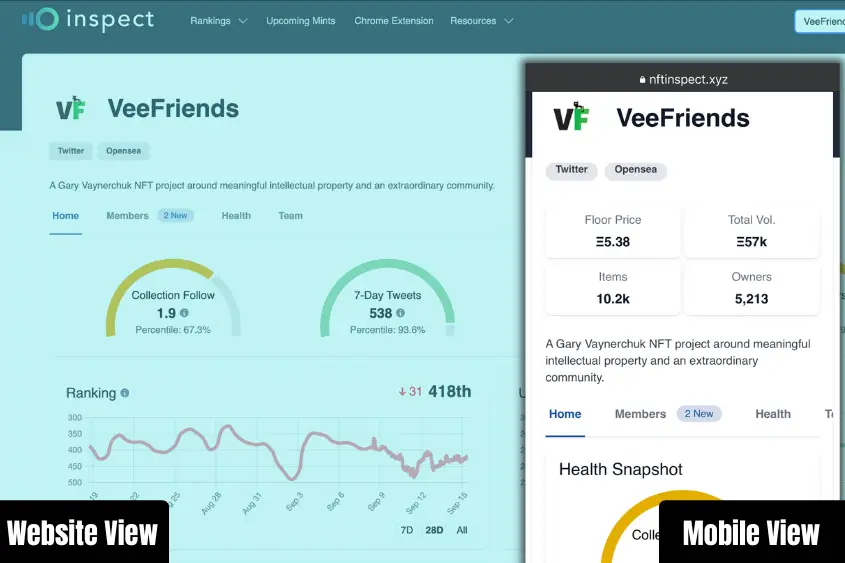
In addition, you can download Inspect’s AI Chrome extension to automatically detect NFTs and their communities on Twitter.
All you have to do is search for an NFT collection on Twitter, go to its profile, and a convenient “Community” button appears, allowing you instant insight into the project and its top community members.
User Experience:
Out of all the tools I’ve tested, Inspect is one of the most unique and enjoyable trackers.
Not only can you view basic details about certain NFT collections, but you gain valuable insight into its community members and their interactions.
Having said that, Inspect is mainly used to observe social interactions of NFT projects, not statistics about the project itself.
This is a perfect tool to use with another NFT data analytics platform to help you make the best investment decisions.
Key features:
- Inspect Chrome extension tool (used to inspect NFT Twitter accounts)
- Collection Rankings (top NFT accounts ranked by community signals)
- Twitter Profile Rankings (Twitter profiles ranked by following and influence)
- Top upcoming and recent mints (plus insight as to who’s talking about the projects on Twitter)
Variety of NFT Collections covered:
Inspect provides social data for Ethereum and Solana NFT projects.
Cost:
Free: Both the inspect website and Chrome extension are free to use.
Like:
- Inspect provides social data that most other rarity and data analysis tools don’t
- The chrome extension makes tracking NFT communities directly on Twitter easy
- It’s free and fun to use
Dislike:
- Inspect hardly provides any statistical info about NFT collections
10. Gem.xyz (Best Overall NFT Aggregator)
Gem is an NFT aggregator that helps you buy NFTs across multiple marketplaces without having to search far and wide to find the best deal.
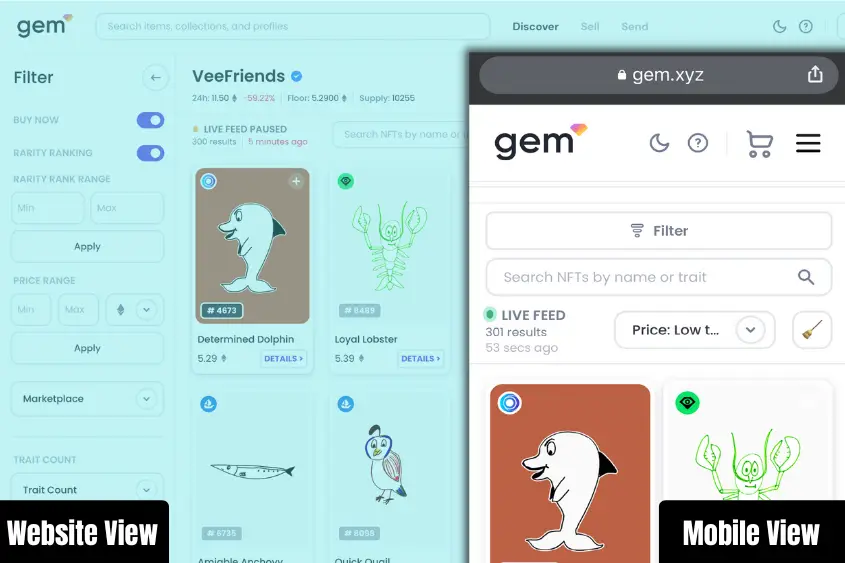
Also, you can pay with any ERC-20 token and Gem provides detailed analytics about every NFT project including sales volume, floor price, and rarity-based rankings.
User Experience:
Gem is one of the best-looking platforms. Not only that, it functions smoothly on mobile and desktop.
By combining its easy-to-use interface with an abundance of NFT collection statistics, Gem is the best overall NFT aggregator.
Key features:
- View trending collections
- Discover the latest sweeps
- Enjoy a live view of NFTs that are currently minting
- Provides rarity rank for each NFT within its collection
- Sell your NFT directly through Gem
- Purchase NFTs directly through Gem while saving up to 42% in gas fees
Variety of NFT Collections covered:
Gem supports aggregation for both Ethereum and Solana NFT collections.
Cost:
Free: Gem is completely free to use.
Like:
- Simple and sleek interface
- Save money and buy directly on Gem
- Rarity filters make it easy to find the best NFT at the lowest price
Dislike:
- Gem only provides aggregation for Ethereum and Solana NFTs
11. Curio (Best Up and Coming Tool)
Curio is an NFT analytics tool that allows you to track deals, trends, and mints in real time.
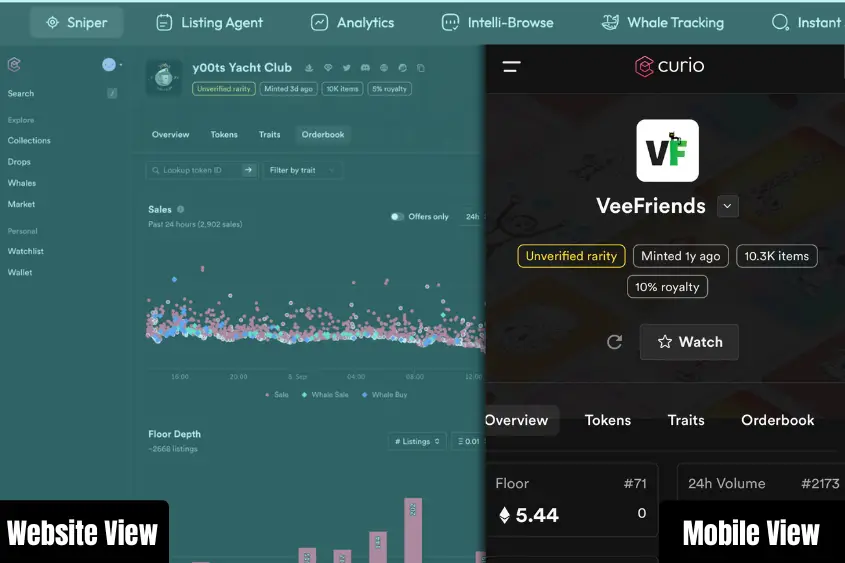
The platform features an in-depth trait checker, watchlists, and more.
Curio uses OpenSea’s API and the Ethereum blockchain to gather its data and plans to incorporate data from other marketplaces soon.
Moreover, Curio is backed by some major thought leaders of web3 including Alexis Ohanian, Gary Vee, Cozomo Medici, and Opensea’s CEO, Devin Finzer.
After managing to raise $5.1 million in funding, Curio is set to be one of the best analytics tools on the market.
User Experience:
To access Curio’s analytics features, you have to sign in using your web3 wallet.
Although this makes complete sense, I’m not too comfortable with it personally. I’d rather use my email.
That said, Curio provides a user-centric analytics platform that displays everything you need to make the best buying decisions, all in one place.
The website works properly and the mobile page functions well also.
But, certain mobile pages are slightly too wide so you have to scroll right to left a bit to view the data in its entirety.
If you want access to Curio’s best features such as watchlists, alerts, and trait-level analytics, you will need to buy a membership plan.
Overall, Curio is a well-designed tool that will likely grow to become one of the best.
Key features:
- Curio-deal finder (used to find the best deals and snipe NFTs quickly)
- Personalized watchlists and alerts (Discord and email alerts)
- Live order book allows you to track collection activity in real-time
- Trait-level analytics (view trends for specific traits)
- Upcoming drops calendar
Variety of NFT Collections covered:
Curio provides data for Ethereum NFTs.
Cost:
Free: You have limited access to what analytics you can view with a free account.
1 month: 0.1 ETH/month
6 months: 0.08 ETH/month
1 year: 0.06 ETH/month
Curio Key: NFT membership that provides discounts on Curio Pro, access to pre-release and members-only Discord channels, first dibs on merch drops, and allowlist allocations for upcoming Curio drops.
Like:
- An all-in-one solution to track Ethereum NFTs
- Backed by industry leaders
- Numerous membership options
Dislike:
- Most tools you’d want to use require you to purchase a membership
- Only tracks Ethereum NFTs
- You have to sign in using your web3 wallet
12. HowRare (Best Solana Rarity Tool)
HowRare is an NFT rarity tool used to find out the rarity of Solana NFTs. That’s right. This tool only displays Solana NFTs, but that’s not a bad thing.
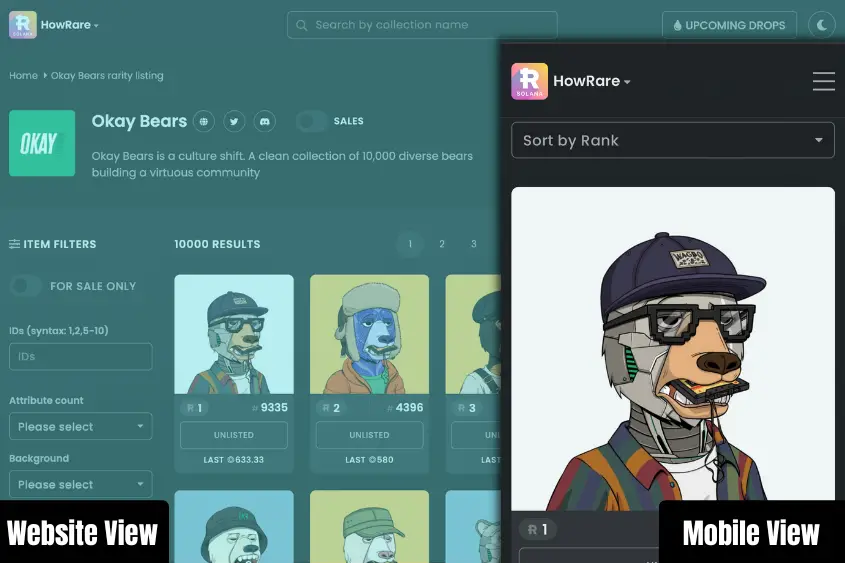
Having a dedicated rarity checker for Solana assets makes it much easier to filter through the various projects.
In fact, HowRare is one the most comprehensive Solana-based rarity tools considering it covers more than 1,000 NFT collections.
User Experience:
HowRare makes finding the rarity of Solana NFTs a cinch.
The homepage lists the top 250 collections allowing you to view the floor price, the number of items and holders, and the number of NFTs on sale in a collection.
To view the rarity of a project, all you have to do is search for it by name or tap on one of the collections listed under the top 250.
From there you will be taken to a super simple rarity ranker with a generous amount of filters to find the exact NFT you want.
This tool works great on both desktop and mobile sites.
Key features:
- Top 250 Solana NFT collections
- Simplified rarity checker
- Several available algorithms for determining NFT rarity
Variety of NFT Collections covered:
HowRare only ranks NFTs on the Solana blockchain. That said, they rank over 1,000 Solana NFT collections.
Cost:
Free: HowRare offers its service for free. It’s also free to list your Solana collection for the Drops page and Rarity ranking. But, there are no guarantees your project will be accepted.
Like:
- HowRare provides a simple user interface
- It’s Solana specific
- There are multiple algorithms and filters for checking rarity
- Their FAQ page answers every question you might have about the tool
Dislike:
- If you want to check the rarity of NFTs on a blockchain besides Solana, this isn’t the tool for you
13. MoonRank (Runner-Up Solana Rarity Checker)
MoonRank is a statistical rarity service for Solana NFTs. The platform ranks and indexes new collections in real time and every collection on MoonRank is ranked using the same algorithm.
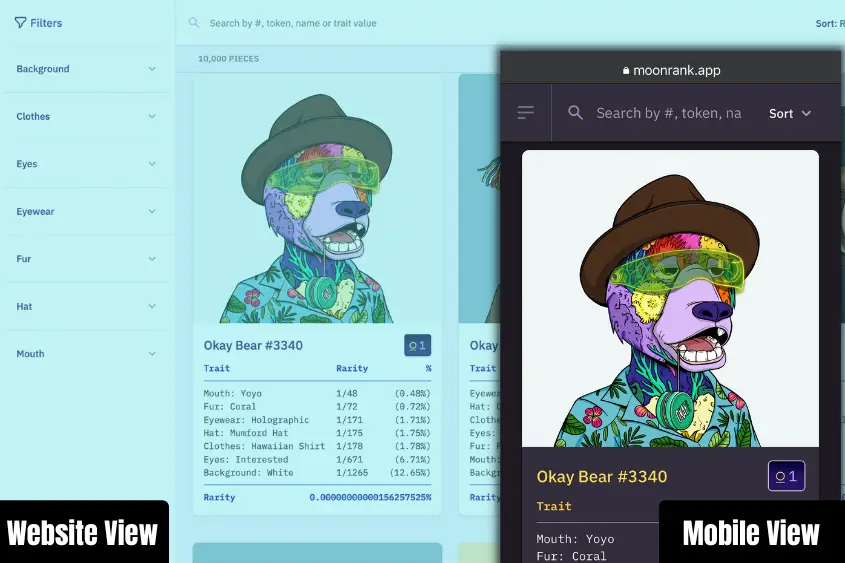
You can view each NFT collection by searching for it or you can check out the featured collections, live mints, and new collections listed on the homepage.
If you want a no-BS tool to check the rarity of your favorite Solana NFTs, MoonRank is worth trying out.
User Experience:
MoonRank makes checking rarity easy. Upon visiting the site, you’re greeted by a wall of NFT cards that display a brief description of the project and the total amount of tokens in a collection.
You can easily find new projects using this feature, or you can search for projects if you know you which one you want to check the ranking of.
When visiting the ranking section, you will find all the data you need such as the mint info, rarity chart, and creator actions.
Ultimately, you gain insight into each NFT collection far beyond its rarity.
Checking rarity is easy too. With numerous traits filters and a ranking score on each NFT, you can pinpoint the level of rarity you’re looking for instantly.
I will say that this is one of the slower websites I tested.
On both mobile and desktop, it takes a few seconds to load certain pages. It’s not unbearable though.
Key features:
- Featured collections
- Live mints
- Newly listed collections
Variety of NFT Collections covered:
MoonRank covers a large number of Solana NFT collections.
Cost:
Free: MoonRank is free to use and free to submit a project to have it listed.
Like:
- MoonRank is transparent about how they rank NFTs
- They use statistics (not weight) to rank NFTs
- Doesn’t charge creators to rank NFTs
- Very clear and accessible rarity chart for each project
- They have a live index showing mint info in real time
Dislike:
- You won’t get a ranking of non-SOL projects
- The page speed can be slow at times
14. NFTBank (Best NFT Portfolio Manager)
NFTBank is an all-in-one solution for managing your NFTs. It’s perfect for managing your portfolio, gaining market insight, and even assits with tax filing.

In addition, NFTBank provides you with the most accurate net worth snapshot of your portfolio and covers over 1,800 projects.
Perhaps most notable is NFTBank’s mobile app which allows you to manage your NFT portfolio on the go and view analytics for your favorite projects.
It takes two seconds to sign up, and you can connect your web3 wallet to gain further insight into your bag.
User Experience:
NFTBank is unique in that it’s not only a decent NFT data analysis tool that tracks floor price, listing price, and rarity rank, but it’s one of the only tools that give you extensive insight into your own wallet(s).
The website is simple to navigate with big buttons on both sides, and all of the data is laid out well in the middle.
Also, the mobile app is even better and works well without any hiccups.
If you are looking to track NFTs and learn more about your own portfolio, I think NFTBank is the best choice.
With the ability to follow wallets and gain insight on other top traders, plus foster your own followers, NFTBank has a social element that I enjoy too.
Key features:
- Tax filing services are offered directly through the platform (plus discounts)
- Wallet portfolio stats (revenue, spending, ROI, and inventory value)
- NFT price search
- NFT rarity rank
- iOS and Android app
Variety of NFT Collections covered:
NFTBank only covers NFTs on the Ethereum blockchain.
Cost:
Free: NFTBank is free to use and the apps are free to download.
Like:
- Gain insight into your wallet and others
- Easily view NFT rarity rank
- Discover whether an NFT is underpriced or overpriced
- Directly links to Opensea for easy purchasing
- Respectable discounts for multiple NFT tax services
Dislike:
- NFTBank is more of a wallet portfolio manager than an NFT tracker
- You only gain insight into Ethereum wallets and NFTs
15. MomentRanks (Best NFT Community Data Platform)
MomentRanks is a home for NFT communities; providing NFT valuations, rarity, marketplace tools, the latest sales trends, and a lot more.
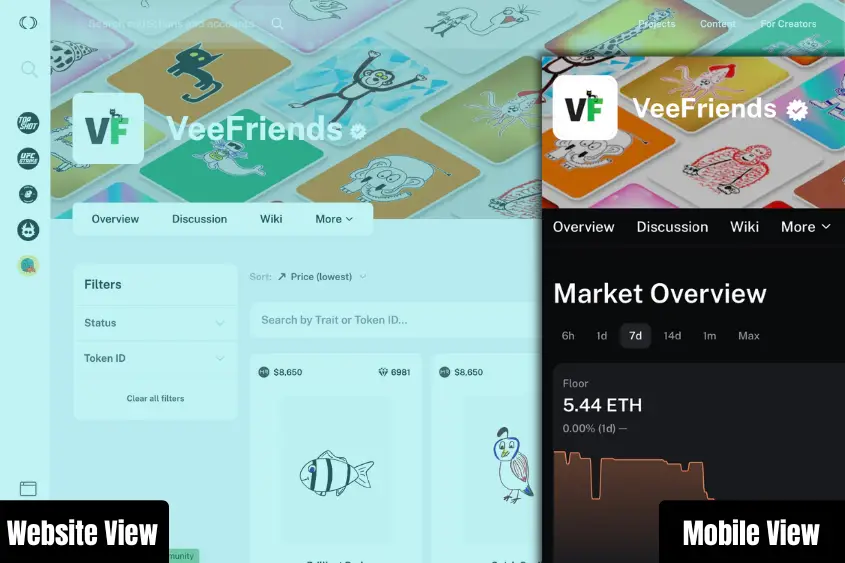
You can use MomentRanks to build your community through discussion, governance, and more.
With over 100,000 NFT collections listed, you’re sure to find all the details of any NFT collection you’re looking for.
User Experience:
MomentRanks is the holy grail of NFT project overviews.
Not only can you easily find all the analytical data you need about an NFT such as floor price, sales volume, sales history, and traits, but the platform offers a complete overview of each project and has a live feed of the project’s Discord announcements.
The website works well, however, the overview page can be a bit of a pain as the scroll function doesn’t always work the way you want it to.
The good news is that the mobile webpage works exceptionally well though.
Key features:
- Project overview including an about section, top holders, and recent listings
- A discussion area where community members can chat (the project has to enable this function)
- A Wiki page with additional info
- Marketplace (search and buy directly on Opensea)
- Analytics (offers a complete overview of NFT projects)
Variety of NFT Collections covered:
MomentRanks provides data for Ethereum NFTs.
Cost:
Free: MomentRanks is free to use.
Like:
- Learn more about an NFT project’s mission and brand
- View analytics and find good deals directly within the platform
- View the latest updates from each project’s Discord announcements
Dislike:
- Only covers Ethereum NFTs
- The overview page doesn’t always work well on the desktop version
16. Icy.tools (Good for Beginners)
Icy.tools is an NFT tracking and analytics platform that provides data about the latest floor prices, sales volume, and sale history of Ethereum NFTs.
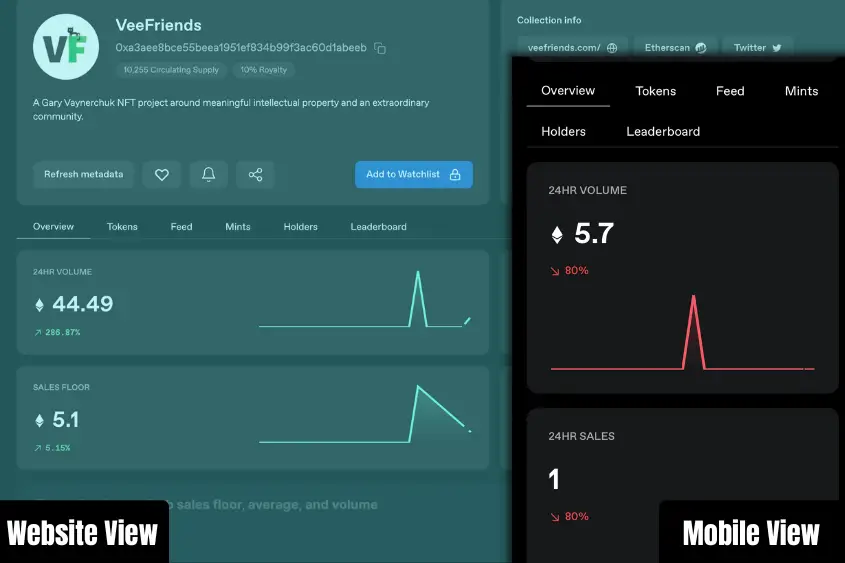
Icy takes things a step further by enabling you to view data via simple charts and discover the latest trending projects being minted, along with the transaction history and portfolio value of any wallet.
Furthermore, Icy will alert you of the latest mints and any activity of the wallets you follow.
User Experience:
Icy.tools was one of the first NFT analytics platforms I discovered when they launched back in 2021.
I always appreciated the platform’s user-friendly interface, easy navigation, and helpful charts. The website even displays Ethereum’s latest block number, gas price, and ETH price.
The only thing that gets to me is that you have to pay if you want access to certain features, such as real-time updates.
There are other analytics platforms I’d use before paying to use Icy.
But, if you are looking for a decent tracker for Ethereum NFTs, Icy works well on desktop and mobile devices.
Key features:
- Collection and wallet search
- Upcoming NFT drop calendar
- Customizable watchlist
- Simple charts for tracking various NFT metrics
Variety of NFT Collections covered:
Icy.tools only provide data for Ethereum NFTs.
Cost:
Lite: The Lite version of Icy is free to use for everyone.
Premium: $62/month with additional access to charts, watchlists, favorites, notifications, and more.
Like:
- Icy has a good track record
- A simple platform that’s good for beginners
Dislike:
- Only useful for Ethereum NFTs
- You have to pay to use some of their best features
17. Moby (Best Runner-Up)
Moby is an NFT data analysis platform designed to help traders and investors make educated decisions.
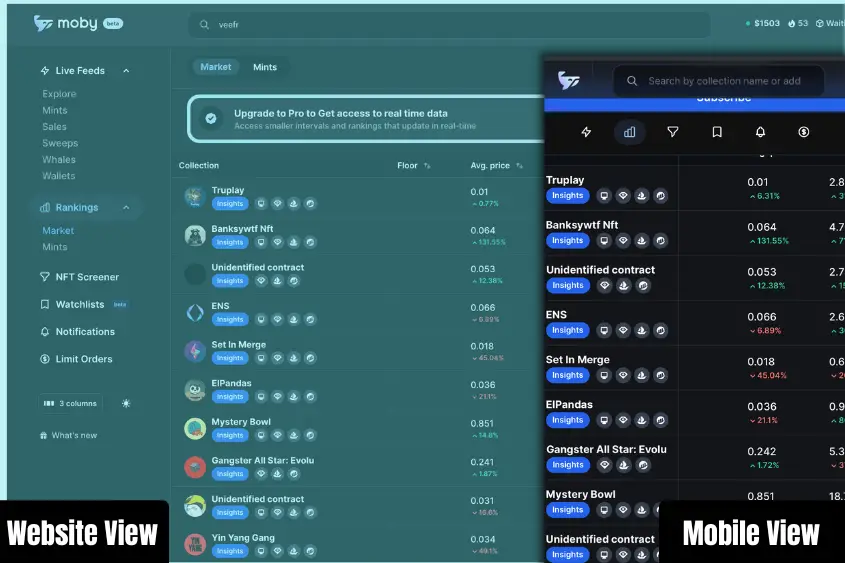
With live NFT minting and sales insights, wallet tracking, and price trends, Moby makes it easy for anyone to become track the best NFT collections.
User Experience:
Moby is a clean platform that offers a plethora of information to help your track a variety of NFT brands.
For as much data as Moby provides, the website is still user-friendly.
Most of the data you might be looking to explore (NFT collection insights) are only available via the paid plan which you have to sign up for using your web3 wallet.
Furthermore, the mobile version functions similarly to the desktop, except the amount of horizontal information displayed on the page leaves you no choice but to swipe left or right to see everything.
Key features:
- Live feed analytics
- Market and mint rankings
- NFT Screener lets you combine custom filters to build your own rankings
- NFT Watchlist
- Real-time notifications via Discord, Telegram, and your phone
- Limit Orders allow you to instantly buy new Opensea listings that meet your set criteria
Variety of NFT Collections covered:
Moby covers a large number of NFT collections on the Ethereum blockchain.
Cost:
Free: The free version offers access to the most basic features.
Pro: You can upgrade to a Pro account for 0.1 ETH for a 6-month subscription.
Like:
- The website is clean looking and easy to navigate
- You can have real-time notifications sent directly to you
Dislike:
- Most of the features you’d want to use are only available on the paid version
- You can only sign up using your web3 wallet
18. Etherscan Token Tracker (Most Accurate Ethereum Data Tracker)
Etherscan is Ethereum’s official blockchain explorer. If you want to find out any information regarding the Ethereum network, you will find it on Etherscan.
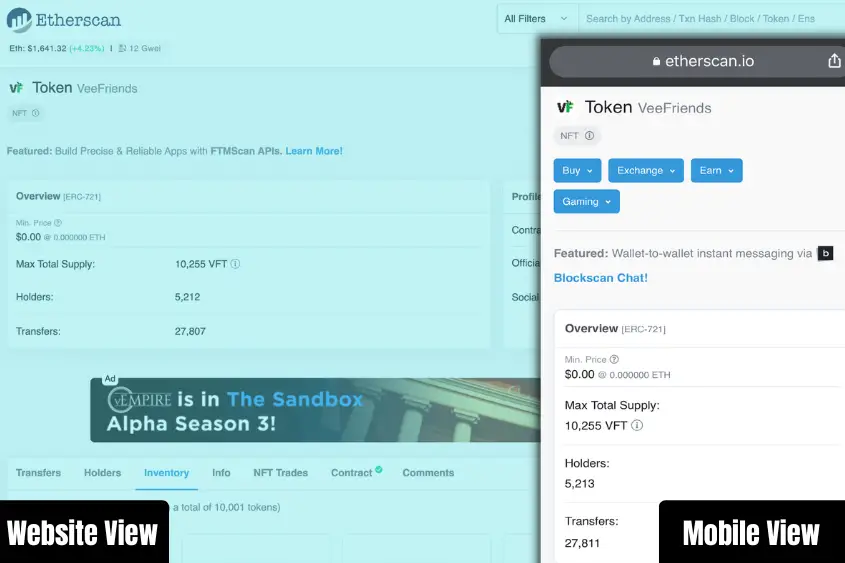
In addition, you can use Etherscan to track any NFT project on Ethereum.
That’s not to say that Etherscan was designed specifically to track NFTs, however, it does have that capability. It’s just not as pretty as other platforms that were designed with the end user in mind.
User Experience:
Etherscan is a raw analytics tool. It has one job, and that’s to allow anyone to track any and all activity on the Ethereum network.
That means every single transaction that has ever occurred on Ethereum, can be found using Etherscan.
As you can imagine, that’s a lot of data. For someone who really enjoys numbers and has a decent understanding of how blockchain technology works, Etherscan is an extremely useful platform.
You can easily track NFT collections by their name, contract address, or token id.
But to be honest, Etherscan would not be my first choice if I were searching for data regarding an NFT project.
Not because it doesn’t work or it’s not accurate (it’s actually the most accurate for Ethereum NFTs), but simply because there are better solutions.
Key features:
- Track NFTs by contract address, name, and token id
- View every single transaction of any Ethereum NFT collection
- View the top 1,000 holders of any collection ranked by the total number of assets owned
- View a complete inventory of every NFT project listed
Variety of NFT Collections covered:
Etherscan covers every single transaction on Ethereum. That means you can view information regarding every single NFT project on this network.
Cost:
Free: Etherscan is a completely free tool that’s available to anyone.
Like:
- Etherscan is the most accurate Ethereum NFT analysis tool
- It’s free to use for everyone
Dislike:
- Etherscan was not made solely for tracking NFTs.
- You can get lost in the technicalities of all the blockchain data
- You are limited to only tracking Ethereum NFTs
19. Nansen (Best Analytics Platform for Professionals)
Nansen is a blockchain analytics platform that analyzes and labels over 100 million blockchain wallets and their activities.
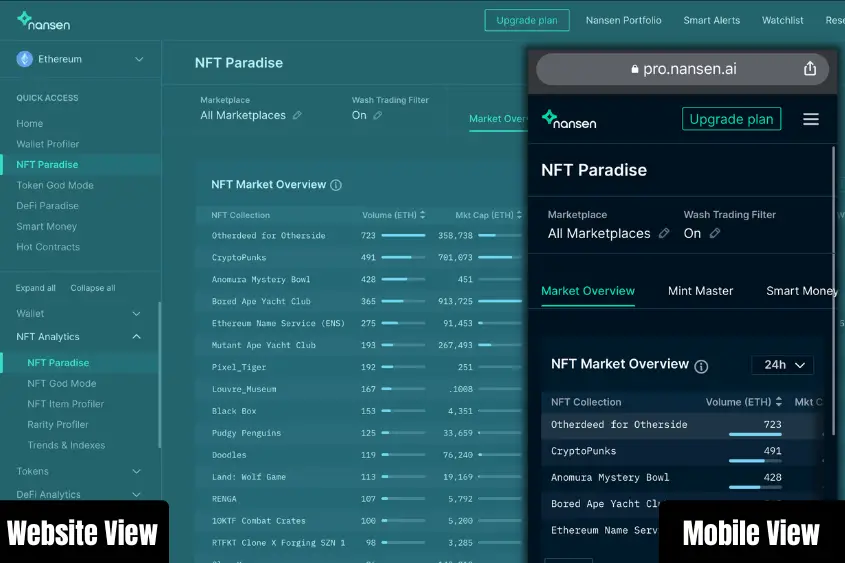
Serious investors and industry professionals utilize Nansen’s extensive data to discover new opportunities and perform due diligence.
The platform’s smart feature also notifies you when an entity mints, buys, sells, or transfers NFTs. Moreover, Nansen provides cross-chain analytics with 10 blockchains.
If you are serious about investing in NFTs and want the most professional service with unique features, Nansen is as good as it gets.
User Experience:
Although I was only able to test the free version, Nansen still provides an impressive amount of data for numerous NFT projects and marketplaces spanning 7 different blockchains.
The platform is easy to use, but there is a lot of data that can quickly consume you.
Key features:
- Nansen Research Portal (high-level articles and podcasts covering important web3 topics)
- Wallet Profiler (input any wallet address for a complete overview)
- NFT Paradise (marketplace and NFT collection overview with a wash trading filter)
- NFT God Mode (an overall perspective of specific NFT collections you choose)
- NFT Item Profiler (track price and trades of NFTs over a specific time period)
- Rarity Profiler (an overall perspective on your trait of choice)
- Trends and Indexes (various trends regarding numerous types of NFTs)
Variety of NFT Collections covered:
Nansen provides NFT data for 7 blockchains including Ethereum, Polygon, Avalanche, Arbitrum, BNB Chain, Ronin, and Solana.
Cost:
Free: Some basic analytic features are free if you create an account.
Standard: $89-$149/month
VIP: $899-$1,490/month
Alpha: $1,799-$2,999/month
Enterprise: Contact Nansen for a quote
Like:
- Best platform for serious investors
- Perfect to help with risk management
- Various membership levels for all types of users
Dislike:
- The paid plans are extremely expensive
20. Rarity Sniffer (Most Basic Rarity Checker)
Rarity Sniffer is one of the most simple rarity tools on the web. That said, it lacks basic navigation features that most other tools offer.

Of course, you can use the search bar to locate NFT collections by name or contract address, but there’s not much else beyond that.
As far as viewing the rarity of an NFT, Rarity Sniffer actually does a nice job.
You can filter by traits, pricing, whether an NFT is for sale or not, and view the overall rarity score of a particular NFT.
Plus, if you want to buy it, Rarity Sniffer conveniently links you to the project’s Opensea page.
There are some other basic stats listed for each collection such as the total number of items, reveal percentage (how much of the project has been revealed), floor price, total sales volume, blockchain, and contract address.
User Experience:
Despite lacking helpful tabs on the homepage, Rarity Sniffer offers a super simple platform for discovering the rank of an NFT.
The website functions well on both desktop and mobile versions. But ultimately, it leaves me wanting more options.
Key Features:
- Search collections by name or contract address
- Offers helpful blog posts
- View upcoming collections
- You can follow collections you’re interested in
Variety of NFT Collections Covered:
Rarity Sniffer significantly lacks NFT collections that you’d expect to be able to track.
Cost:
Free: The tool is free to use. Also, as long as your NFT project meets Rarity Sniffer’s minimum requirements, listing is free. If you don’t meet the requirements you have to pay a fee.
Like:
- Supports Ethereum, Polygon, and Solana networks
- Super simple user-interface
Dislike:
- Minimal search functions
- Lacks major NFT brands
- It’s almost too simple
21. Dune Analytics (Most Complicated Analytic Tool)
Dune is an on-chain platform that provides users with extensive data on various crypto projects including NFTs, DeFi, and other blockchain platforms.

Anyone can use, create, and share queries on the platform.
As a result, the platform contains a ton of analytical data, thousands of charts, and various data points.
User Experience:
I’ll start by saying it’s a mess. The dashboard used to view data looks like an old-school forum, and since everything is created by users, there’s an unlimited supply of data points.
Dune provides a lot of helpful analytics regarding various NFT collections, but, only if you can find what you’re looking for.
Sure, there’s a search function but a simple search results in numerous reports.
It’s a fun platform to explore, but I don’t recommend it for tracking NFTs or viewing rarity. There are better options.
Key features:
- Thousands of charts and data points
Variety of NFT Collections covered:
Dune provides analytical data for Ethereum, Polygon, BNB Chain, Optimism, and Gnosis Chain.
Cost:
- Free: All the basic functions are free to use.
- Dune Pro: $390 per month / per user. The Pro version allows you to export results to CSV, keep queries and dashboards private, skip the query queue, and run 6 queries in parallel.
Like:
- Charts created by users offer a new perspective
- You can share your data points with others on the platform
Dislike:
- The interface is too messy to navigate
- It’s hard to find exactly what you’re looking for in a timely manner
What Is NFT Rarity?
NFT rarity determines the overall rank of a token compared to other NFTs within a collection. Rarity is the result of calculations based on several traits found in an NFT collection. It originated from the CryptoPunk NFT collection and has grown to offer holders various perks based on rarity level.
There’s no doubt that rarity is one of the main forces driving the collector economy in the digital collectibles space.
However, it’s important to point out that rarity isn’t the only force.
In order for the rarity of an NFT to matter, the collection has to be meaningful to society.
For example, the rarity of a Pokemon card matters. The rarity of 100 cards I make myself, doesn’t matter.
Why?
Because Pokemon built a meaningful intellectual property around its brand.
Whereas, I haven’t.
Hence, just because you create “rare” NFTs doesn’t mean they’re actually rare.
First, you have to make the brand matter. Or, you have to provide different levels of value through various levels of rarity.
Basically, value is the key. Without value, there’s no incentive to own a “rare” NFT.
How Does NFT Rarity Tools Score Work?
The rarity tool score takes into consideration all of an NFT’s traits to determine its overall rarity in a collection. The rarer an NFT is the higher the score will be (1 being the rarest), whereas lesser rare NFTs will have lower scores. You can use these scores to quickly identify the rarest NFT in a collection.
How to Check the Rarity of an NFT
To check the rarity of an NFT you can use a rarity check tool. This tool determines the rarity of an NFT in its collection. Or, you can use an NFT data analysis tool to determine the overall rank of an NFT collection compared to other collections on the market. Both tools used together are best.
That said, let’s discuss the difference between a rarity tool and a data analysis tool.
NFT rarity tool tracker
An NFT rarity tool is best for helping you determine the rarest NFT in a collection.
Although this can be a helpful tool to quickly locate the rarest NFT, it won’t help you figure out which collection is performing the best on the market.
NFT data analysis tool
A data analysis tool tracks and analyzes various aspects of NFT projects across the entire market.
These tools track sales volume, floor price, the number of holders and buyers, and changes in volume, along with other important data used to find the best NFTs.
An NFT data analysis tool is great for overall market statistics, but won’t necessarily help you find the rarest NFT in a collection.
That’s why using both a rarity and data analysis tool together is the ultimate way to discover the best-ranking NFTs and collections.
Does NFT Rarity Really Matter?
NFT rarity is important because it helps drive demand in the market and enables brands to diversify their digital asset offerings via various levels of traits and utility. Without different rarity factors, it would be difficult for brands to offer tiered products and services.
In the physical world, it’s easier to differentiate the ranking of products by comparing the different aspects.
For example, a vehicle has varying levels of rank based on what it offers.
The base model comes with standard wheels, seats, and the least powerful engine.
The mid-level has upgraded wheels, two-tone seats, and a better engine.
Whereas the premium tier offers consumers the full package; leather seats, bigger wheels and upgraded brakes, and the best-performing engine.
But, in the digital world, it can be more difficult to determine the rank considering digital assets are not tangible products.
Hence, rarity is used to differentiate the different levels of access and utility.
Finding the best NFT rarity and analytics tool is a cumbersome task. With so many options, it quickly becomes overwhelming.
That’s why I tested and ranked each tool and reviewed them based on their ease of use, key features, variety of NFTs covered, and cost. Now all you have to do is find the best NFT.

1 thought on “21 Best NFT Rarity Tools (Tested, Ranked, and Reviewed)”
Comments are closed.